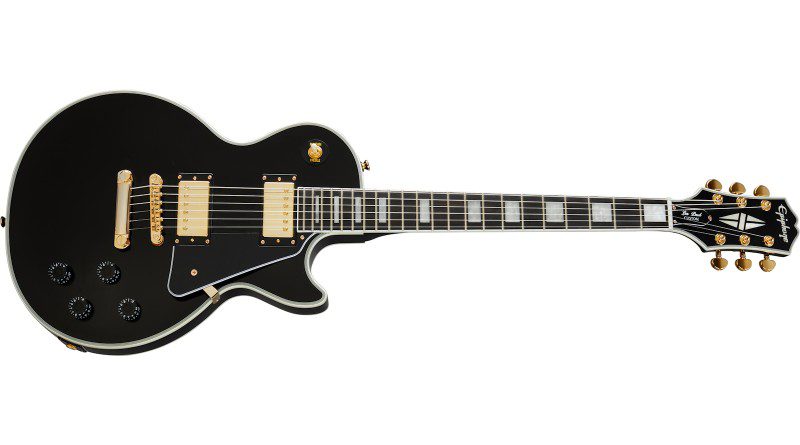The Gibson Les Paul is one of the most iconic guitars ever made, but unfortunately, due to their prices, these guitars remain simply out of reach for many. However, since Gibson began producing lower cost versions of the Les Paul through their subsidiary brand, Epiphone, players have been heavily drawn to these guitars because it gives them the chance to own a real Les Paul for a fraction of the price they’d pay for a Gibson branded model.
For some, though, getting past the name on the headstock if it says anything other than Gibson is a problem, so in order to buy guitars with the logo they want, at an affordable price, they turn to ecommerce sites, where a cottage industry of counterfeit guitar manufacturing has spawned.
If you’re buying one of these “Chibson” guitars for yourself, that’s your business, but where it becomes really problematic is when individuals buy cheap knock offs with the intent of selling them on at actual (or close to) Gibson prices. Thankfully, the general guitar buying public is a bit more clued in to this than they were a few years ago, but this is where things get really complicated – Fake Epiphone Les Pauls.
In this KillerGuitarRigs guide, we talk about why fake Epiphones exist, where they’re made, and how you can easily spot a knock off. If you’re thinking about buying an Epiphone Les Paul sight unseen, you won’t want to miss this!
Contents
Background on Fake Epiphone Les Pauls
When it comes to Epiphone specifically, one of the first things that many say when we talk about spotting fakes is, “do fake Epiphones even exist?”, or “why would anyone fake a budget guitar?”. The answer is fairly simple – the unsuspecting guitar buyer is much less likely to think an exceptionally low price on an Epiphone Les Paul is too good to be true. This means the counterfeits are more likely to slip through the net and into general circulation.
Let’s say it costs $50 to make a fake Les Paul, no matter what it says on the headstock. Yes, someone might buy fake Gibson Les Pauls to sell on for $1000 each, making huge profit – the problem is, the buying community is much more skeptical of Gibson models. Too cheap and that’s a red flag. Sell them at standard rates, and people will want to examine closely due to the larger investment.
However, when it comes to fake Epiphone Les Pauls, if they sell for $300, people are far less likely to be suspicious. The profit margin is smaller, but the sale becomes easier.
The lengths that the manufacturers go to in order to copy the appearance of the real thing is frankly astounding, so it’s no wonder that these fakes often attract buyers with their lower price points and seemingly genuine appearance.
However, fake Epiphone Les Pauls tend to lack in the areas that really matter – the sound quality, build quality, and the overall durability that genuine Epiphone Les Pauls, particularly modern models, are well known for. The counterfeiters’ ability to replicate the guitar’s aesthetics while cutting corners on quality has led to a huge number of these fakes being sold to unsuspecting buyers, particularly on platforms like Craigslist and Facebook Marketplace.
Are Epiphone Les Paul Fakes Made In The Same Factory As The Originals?
Many people also believe that counterfeit Epiphone Les Pauls are probably made on the same shop floor as the originals. This could not be further from the truth. The Gibson Corporation and their Subsidiary, Epiphone, employ strict quality control across their foreign manufacturing facilities, and the chances of an underground counterfeit operation happening under their watch is slim to none.
These knock off guitars are made in unregulated facilities, likely using less than legal labor. They do not worry about the quality of the components being used in the instrument, so the cheapest possible parts are used, for maximum profits. There’s also a chance that there are glues, paints, or other chemicals that could be hazardous to human health in use on these guitars.
How to Spot a Fake Epiphone Les Paul
While the accuracy of counterfeit Epiphone Les Paul guitars is rapidly improving, there are some surefire signs that the instrument you’re looking at isn’t genuine. Fortunately, these signs are common amongst fakes, making them fairly easy to spot once you’re aware. We’ve highlighted the main areas that you need to look for below.
Headstock Logo and Branding
While the counterfeiters are generally getting better at producing convincing fakes, one thing that they often goof on is the most obvious focal point on the whole guitar – the headstock logo.
The logo on a genuine Epiphone is always properly centered, with a consistent font, and will be very nicely applied. The same goes for the “Les Paul Model” signature, which should not only be properly aligned and well applied, but should be matte gold in finish.
If it’s a Custom model you’re looking at, the diamond motif inlay is often another dead giveaway. This is often skewed on fakes, and will look extremely obvious if it’s not properly aligned.
While we’re talking about headstocks – Epiphone has used a number of different headstock shapes, so this can present challenges if you’re trying to use this as a measure of authenticity. Les Pauls made after 2020 (with the exception of the “Special” models with bolt on necks), have almost all been made with the “Kalamazoo” headstock design, not the older “Clipped Ear” or “Dove Wing” shape. The one exception is the new Kirk Hammet “Greeny” signature, which is currently the only Epiphone with a Gibson “Open Book” headstock design.
Tailpiece and Bridge Placement
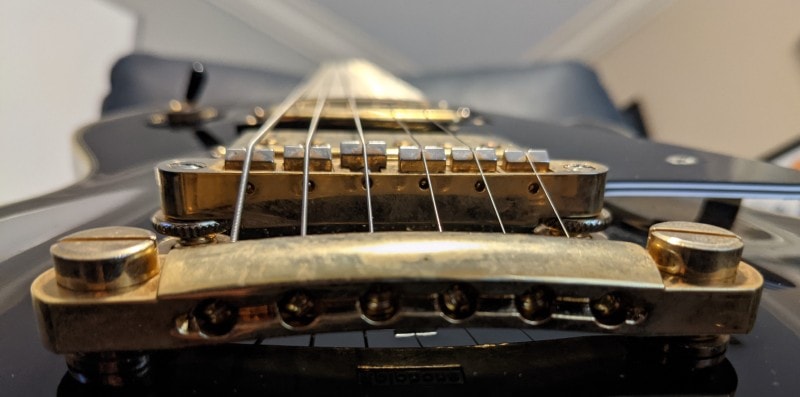
One of the first things to look for when dealing with a counterfeit is the tailpiece bolt heads. Fake Epiphone Les Pauls often have a domed bolt atop the tailpiece posts. An original will always have bolts with a flat top and slightly rounded edge.
The placement of the tailpiece and bridge are also critical in determining the authenticity of an Epiphone Les Paul. On real examples, the placement and alignment of these components, which is essential for a stable and properly intonated instrument, is going to be bang on perfect. This isn’t always the case with fakes.
These components may be improperly aligned or made with poor quality materials in fake guitars. These inaccuracies not only detract from the guitar’s aesthetics but more importantly, affect its functional performance.
Pickguard Mounting Screw
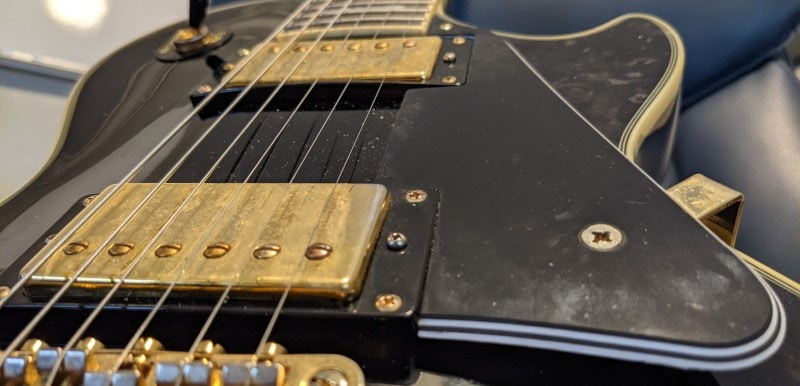
This one is a little harder to spot for the untrained eye, so having a known original to compare it with, even just a photograph of one, will be helpful. Counterfeit Epiphone Les Paul pickguards are widely known to have their mounting screw located close to the bottom edge of the pickguard itself. On an original Epiphone guitar, this screw will be located closer to the middle of the scratch plate.
Tuners
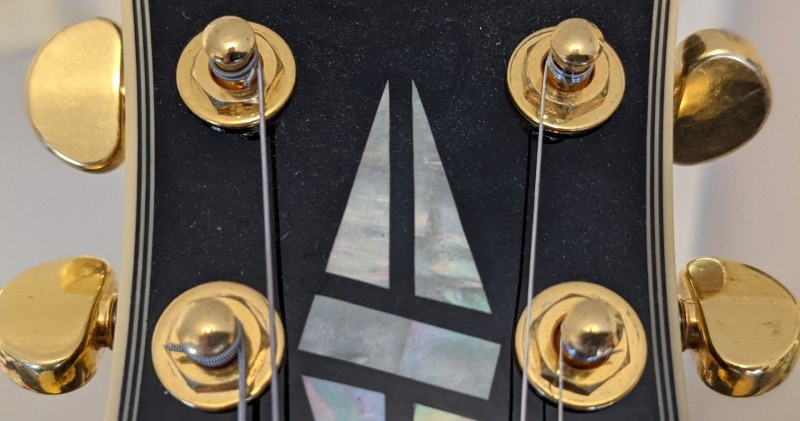
Counterfeiters are usually quite bold, and will often attempt to make their copies look as high end as possible. This means that not only do they fake the guitar, but they also make fake Grover tuners. Much like the rest of the guitar, the quality is often shoddy, and feature dead giveaways as to their authenticity. First, look at the front of the headstock. Under the tuning post bolts, these counterfeit Grover tuners will have a large washer with a sloped profile. If a genuine Epiphone Les Paul is equipped with Grover tuners, this washer will have a much smaller diameter.
On the back side of the tuner, the classic Grover dome is where you need to look next. Counterfeit examples will tend to have a matte finish on the domed area, whereas a genuine Grover tuner on a real Epiphone Les Paul has a mirrored finish.

Finally, the font used on the Grover branding is another indication you should be looking for. On a fake Epiphone Les Paul, if it features “Grover” tuners, the lettering on the branding is tall, almost rectangular. On original Grover tuners, this lettering is more compressed, and each letter almost takes the form of a square.
Volume And Tone Controls
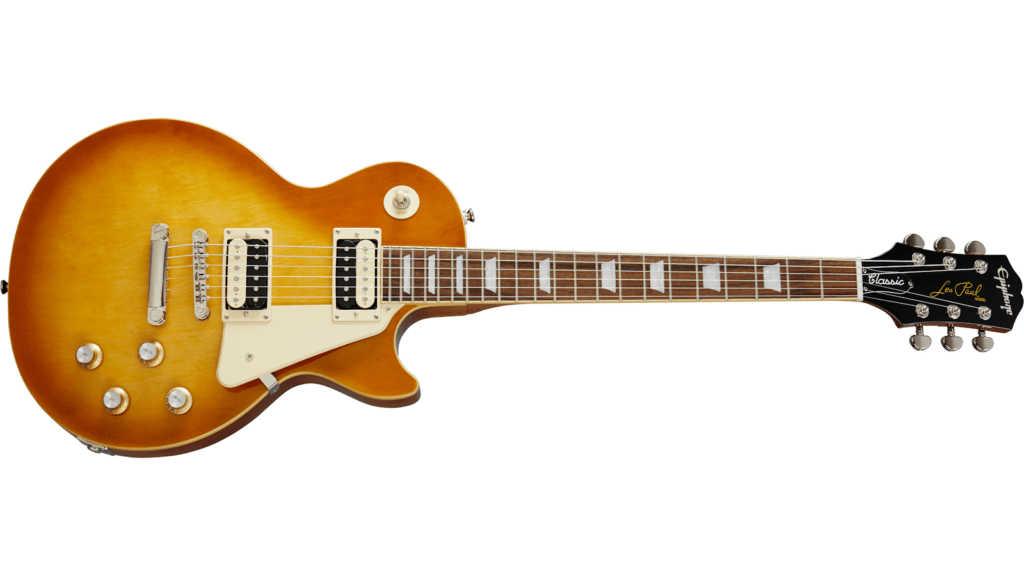
One thing that the counterfeiters can never seem to get right (fortunately!) is the location and layout of the volume and tone knobs. Fakes will frequently have uneven spacing between the controls, which might not be readily visible to the naked eye, but there is a trick to checking the proper alignment. If you have a picture of the guitar you’re concerned about, draw a line that passes through the volume knobs, another that passes through the tone knobs, and finally one that passes directly from the center of the tail piece to the center of the headstock.
If these 3 lines are anything other than perfectly parallel with each other, this is a sign that you should steer well clear as there’s a good chance it could be a fake.
Body Shape, Weight, and Overall Feel
This is trickier to spot unless you’re already familiar with how a genuine Epiphone Les Paul looks and feels, but counterfeits do frequently feature irregular proportions when compared side by side with an original. The horn is often too pointy, or too round, and the bottom “bulge” is often too large. Additionally, carved models (when fake) often don’t have a smooth graduation from the edge to the peak of the top.
As for weight, just like Gibson Les Pauls, Epiphone Les Pauls can be quite heavy, reaching upwards of 11lb in some cases. If you come across an Epiphone Les Paul that feels suspiciously lightweight, particularly when it comes to Standards and Customs, this should be an alert to look a little more closely at some of the other potential tells.
Headstock Binding
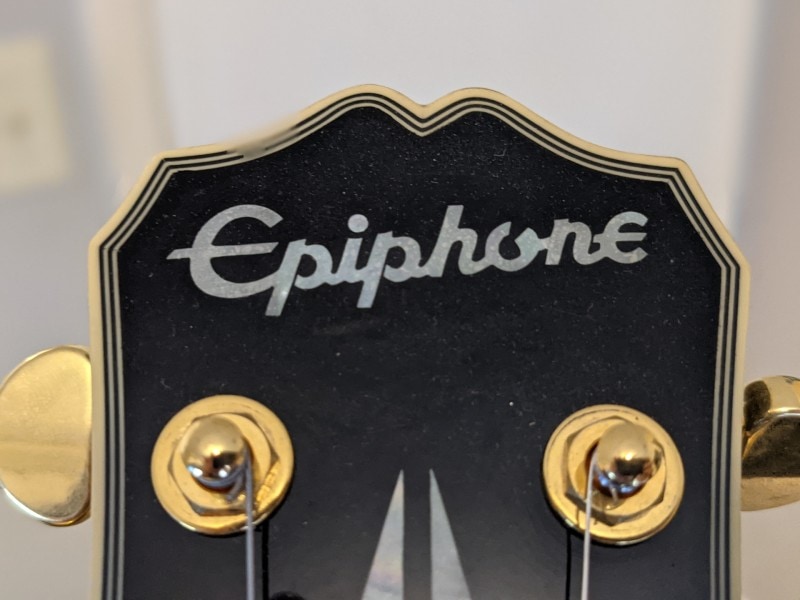
This is one of the most instantly recognizable features of a fake that should send potential buyers running for the hills. Fake Epiphone Les Pauls are often Custom or Deluxe models, as the originals tend to command a higher price and this maximizes profits for counterfeiters. As such, they will feature a bound body and headstock. Look carefully at that headstock binding. Knock offs will, more often than not, have binding there that is so thick, it’s actually close to half the width of the headstock edge. The genuine artifact, if sold with a bound headstock, will have binding that is no more than 3mm, or around 0.1 inches in width.
This isn’t to say there are no fake Epiphone Les Paul Standards on the market, but as they should not have headstock binding,you shouldn’t automatically assume a LP with no headstock binding is genuine without thorough inspection.
Serial Numbers
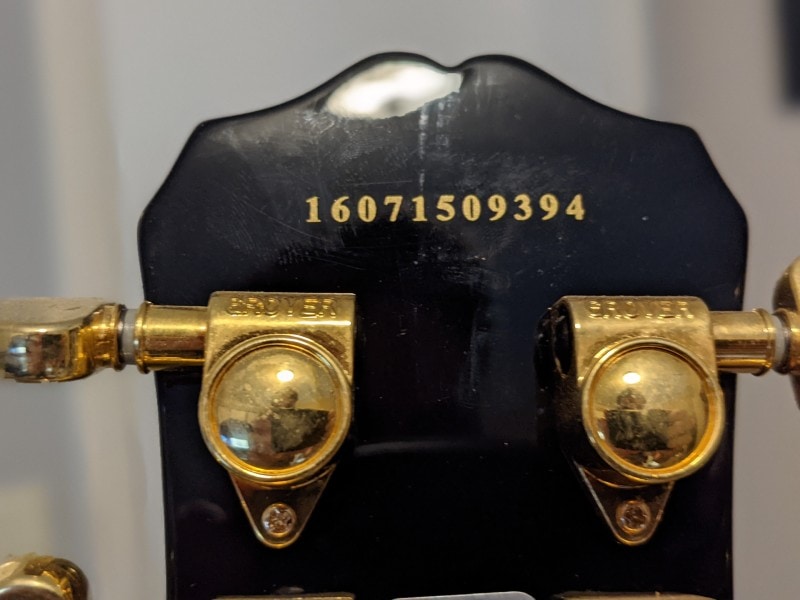
There are a number of websites online that suggest they can not only date your guitar based upon its serial number, but that they can even tell you which factory it was made in. These websites are great, but shouldn’t be relied upon as a dead cert for accuracy – they do not feature a database and instead, use the pattern of letters and numbers in the serial number to make an assumption based upon some known factors. So, even if the serial number on the guitar you’re looking at looks right in one of these websites, The Guitar Dater Project, for example, it could still be a fake.
When it comes to the actual serial number, the overwhelming majority start with the designation “EE”, before the number. There are genuine instruments with this designation, too, so now you should look a little deeper. Look at the size of the EE text in comparison to the rest of the serial number. If it is a significantly larger font, or perhaps even different font altogether, then the guitar is almost certainly a fake.
These serial numbers are often duplicated to other, similar models, too. So, if someone has a number of guitars for sale, and any of the other red flags have been raised, check the serial number of a few of their instruments. If you see any duplicates, walk away immediately.
Wood Quality and Finish
A reputable seller should have no issue with letting you open the electronics cavity on the back of the Epiphone Les Paul they are selling, so, if they allow this, be sure to look inside. When opened up, if you see that the guitar is pieced together from several layers of fiberboard or plywood, walk away. If there are sharp splinters of wood, again, this is a sign that this shouldn’t be the guitar for you!
The quality of wood and the finish used are key indicators of an Epiphone Les Paul’s authenticity. Genuine guitars are made with mahogany bodies and maple caps. On the other hand, fakes may use cheaper materials like plywood, significantly affecting the tone, resonance, weight, and overall feel of the guitar.
The finish is another area you need to pay close attention to. On a counterfeit, the finish may appear similar to an original at first glance, but on closer inspection, you might find that it lacks the depth, and luster of the finish of a genuine Epiphone. Remember, Epiphone Les Pauls have a poly finish, so if someone is trying to imply that they’re selling a model with a nitro finish, there’s a good chance it’s not genuine.
Electronics and Wiring
While you’ve got the cavity open, look at the quality of the wiring. Genuine models are equipped with high quality wiring harnesses and electronic components, properly installed to ensure reliable performance. Fake Epiphone Les Pauls, in contrast, tend to use low quality electronics, which can be easily spotted on close inspection. The wiring in fake often exhibits poor soldering work, incorrect wire thickness, and generally substandard components.
This low quality work not only affects the guitar’s sound quality, but can also impact its reliability and overall lifespan.
Neck Construction
The neck construction is an easy tell when it comes to counterfeits. Epiphone uses both set necks and bolt on necks depending on the model. With bolt on necks, you should be on the lookout for damaged neck pockets, or stress cracks related to over tightening of the bolts. Authentic guitars will have proper torque settings applied to ensure a secure fit without damaging the guitar.
When it comes to set neck models, the joint where the neck meets the body should be smooth, and the paint should be well matched. Counterfeit manufacturers often cut corners when it comes to the neck, using cheaper materials or incorrect construction methods. These alterations can, and most likely will, lead to a notable difference in the feel, looks, and general performance of the guitar. Bad pickups can be replaced, but a bad neck can render a guitar totally unplayable.
Truss Rod Construction
Bad truss rods are another easy way to spot a fake. Genuine guitars receive a proper quality check before leaving the factory, and are very unlikely to arrive at your door with a stripped truss bolt. If the Epiphone Les Paul you’re looking at is being sold as new, and has rough finishing under the truss cover, and/or has a chewed up truss rod bolt, this could indicate a fake.
Another thing to look out for is the type of truss rod in use. Per Epiphone’s customer service department, all Epiphone models come with a dual action truss rod. If the guitar you’re looking at has a single action or fixed truss, it could well be an indicator of a counterfeit.
Final Thoughts
While this guide is primarily aimed at helping prospective buyers avoid the mistake of purchasing a fake Epiphone Les Paul, these tips could also be of use to anybody who has already bought their guitar, but just has that gut feeling that something isn’t right.
If you have purchased a fake Epiphone Les Paul inadvertently or otherwise, it’s not the end of the world. If it plays well and you enjoy the guitar, try not to worry about it – just don’t try and sell it on to someone else as the genuine article. If you aren’t happy, and you purchased it from a retailer and you’ve discovered that it isn’t genuine, gather any proof of purchase and contact them immediately to let them know they sold you a counterfeit, and you should have good recourse for a refund.
Remember, the majority of Counterfeit Epiphone Les Paul guitars on the market specifically target popular, high end, limited edition models like the Zakk Wilde and Joe Bonamassa signatures. These fakes are created to exploit the higher resale value of these specific models, and with an ever increasing lineup of high cost Epiphone special editions (the Kirk Hammett Greeny springs immediately to mind), we’re predicting a large number of counterfeit guitars hitting the market over the next couple of years, making it more important than ever to have an understanding of how to spot the difference between an impostor and the genuine article.

